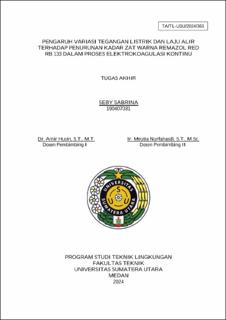| dc.contributor.advisor | Husin, Amir | |
| dc.contributor.advisor | Nurfahasdi, Meutia | |
| dc.contributor.author | Sabrina, Seby | |
| dc.date.accessioned | 2024-08-15T06:37:22Z | |
| dc.date.available | 2024-08-15T06:37:22Z | |
| dc.date.issued | 2024 | |
| dc.identifier.uri | https://repositori.usu.ac.id/handle/123456789/95459 | |
| dc.description.abstract | The use of the synthetic dye Remazol Red RB 133 has a negative impact on the aquatic
environment if waste water is disposed of directly. therefore, electrocoagulation technology is
used to reduce the concentration of Remazol Red RB 133, thereby ensuring there is no impact
on the environment. The aim of this research was to determine the effect of variations in electric
voltage and flow rate on reducing levels Remazol Red RB 133 dye levels in continuous
electrocoagulation. The research found that the maximum removal efficiency of Remazol Red
RB 133 dye concentration was 91.75% at a variable electrical voltage of 14 volts and a flow
speed of 80 mL/minute. | en_US |
| dc.language.iso | id | en_US |
| dc.publisher | Universitas Sumatera Utara | en_US |
| dc.subject | Electrocoagulation | en_US |
| dc.subject | Continuous System | en_US |
| dc.subject | Remazol Red RB 133 | en_US |
| dc.subject | Kinetics | en_US |
| dc.subject | Isotherm | en_US |
| dc.subject | SDGs | en_US |
| dc.title | Pengaruh Variasi Tegangan Listrik dan Laju Alir terhadap Penurunan Kadar Zat Warna Remazol Red RB 133 dalam Proses Elektrokoagulasi Kontinu | en_US |
| dc.title.alternative | The Effect of Variations in Electric Voltage and Flow Rate on Reduction of Remazol Red RB 133 Dyes Content in The Continuous Electrocoagulation Process | en_US |
| dc.type | Thesis | en_US |
| dc.identifier.nim | NIM190407031 | |
| dc.identifier.nidn | NIDN0015026904 | |
| dc.identifier.nidn | NIDN0016128606 | |
| dc.identifier.kodeprodi | KODEPRODI25201#Teknik Lingkungan | |
| dc.description.pages | 51 Pages | en_US |
| dc.description.type | Skripsi Sarjana | en_US |


